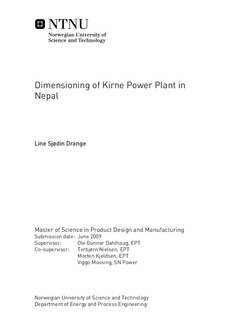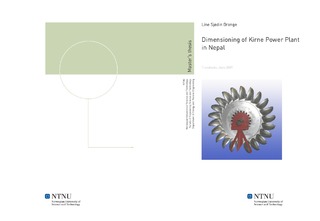| dc.description.abstract | Kirne Power Plant is a planned expansion of Khimti I Hydro Power Plant in Nepal. During the monsoon period there is a lot of excess water, and the the plan is to utilize this water in an extra power plant during the monsoon. The same tunnel as for Khimti I is to be used for the whole volume flow. A new external pressure shaft is planned for the water down to the new power house of Kirne. The hydrology is studied in this thesis, and a flow of 11 m3/s can be utilized in Kirne through 80% of the monsoon, through the rest of the period, the flow is lower, on the average. The flow limit is found based on the head loss and surges in the water way. The sediment basin will have to be doubled in size to handle the doubling of the volume flow. The placing of the basin can be on the opposite riverbank of the existing settling basin. Another possibility is to build the planned power plant Khimti II upstream Khimti I, and handle the sediments there. Excavation of a volume of 170 m3 is necessary at the top of the surge shaft, to give room for the upsurges. The down-surges are reduced by prolonging the opening time of the turbines and valves. The new pressure shaft will be a 1800 meter long external shaft of steel, with an optimal pipe diameter of 2,16 meter. The shaft will be external due to difficult conditions in the rock, and experiences of the building of Khimti I. It will be shown that the best solution for Kirne is to install one Pelton turbine wiht five nozzles, or two Pelton turbines with three nozzles each, in the power plant. Two Pelton turbines will give a better production than one, but at the same time the costs of the power house, and the turbines will increase. The size of the turbine will be 64 MW for one turbine, and 32 MW each, if two smaller turbines are chosen. The production will be about 240 GWh depending of the flow through the year, which can be up to 30% less than the average. The income of Kirne will be about 13-14 MUSD, depending on the final choices. In order to finish this thesis, a lot of assumptions are made. The power evacuation and agreements with locals and national governments are not investigated. This is done to narrow the scope of the thesis, but at these points, the largest risks of the project are placed. | nb_NO |

